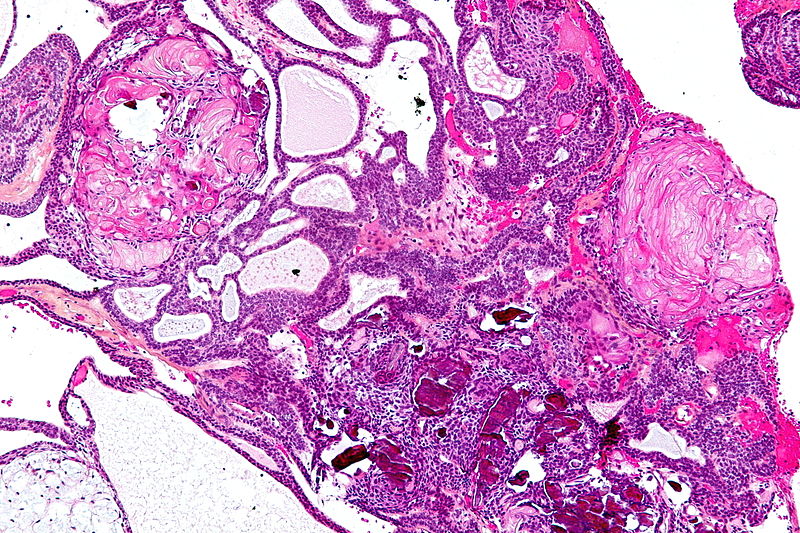Craniopharyngioma pathophysiology
|
Craniopharyngioma Microchapters |
|
Diagnosis |
|---|
|
Treatment |
|
Case Studies |
|
Craniopharyngioma pathophysiology On the Web |
|
American Roentgen Ray Society Images of Craniopharyngioma pathophysiology |
|
Risk calculators and risk factors for Craniopharyngioma pathophysiology |
- Editor-In-Chief: C. Michael Gibson, M.S., M.D. [1]
Overview
Craniopharyngiomas are epithelial tumors that usually arise in the pituitary stalk adjacent to the optic chiasm. On gross pathology, craniopharyngiomas are cystic or partially cystic with solid areas.The cyst is filled with a turbid, proteinaceous material of brownish-yellow color that glitters and sparkles because of a high content of floating cholesterol crystals On microscopic histopathology, it is categorized into two subtypes: Adamantinomatous and papillary.
Pathophysiology
Gross Pathology
- On macroscopic examination, craniopharyngiomas are cystic or partially cystic with solid areas. [1]
- It occur most often in sellar/suprasellar region but can have anterior extension to the prechiasmatic cistern and subfrontal spaces.[1]
- Posterior extension into the prepontine and interpeduncular cisterns, cerebellopontine angle, third ventricle, posterior fossa, and foramen magnum; and laterally toward the subtemporal spaces.[1]
- Craniopharyngiomas are supplied with blood coming from the anterior circulation: perforators from anterior cerebral artery and the proximal portion of the posterior communicating artery.[2]
- Tumor adhesion is the result of local inflammation. Several inflammatory cytokines have been shown to be elevated in the craniopharyngioma cyst fluid compared with cerbrospinal fluid (CSF).[3]
Microscopic pathology
- The histologic pattern consists of nesting of squamous epithelium bordered by radially arranged cells. It is frequently accompanied by calcium deposition and have a microscopic papillary architecture.
- Two distinct types are recognized:[4][5]
- Adamantinomatous craniopharyngioma
- Papillary craniopharyngioma.
- In the adamantinomatous type, calcifications are visible on neuroimaging and are helpful in diagnosis. The papillary type rarely calcifies. On light microscopy, the cysts are seen to be lined by stratified squamous epithelium. Keratin pearls may also be seen. The cysts are usually filled with a yellow, viscous fluid which is rich in cholesterol crystals. In addition to a long list of possible symptoms, the most common presentation include: headaches, growth failure, and bitemporal hemianopsia.
- Shown below is a micrograph showing the characteristic features of an adamantinomatous craniopharyngioma - cystic spaces, calcifications, and "wet keratin" pearls on hematoxylin phloxine saffron (HPS) stain.
- Shown below is a Micrograph showing a papillary craniopharyngioma on HPS stain.
References
- ↑ 1.0 1.1 1.2 Weiner HL, Wisoff JH, Rosenberg ME, Kupersmith MJ, Cohen H, Zagzag D, Shiminski-Maher T, Flamm ES, Epstein FJ, Miller DC (December 1994). "Craniopharyngiomas: a clinicopathological analysis of factors predictive of recurrence and functional outcome". Neurosurgery. 35 (6): 1001–10, discussion 1010–1. PMID 7885544.
- ↑ Duff J, Meyer FB, Ilstrup DM, Laws ER, Schleck CD, Scheithauer BW (February 2000). "Long-term outcomes for surgically resected craniopharyngiomas". Neurosurgery. 46 (2): 291–302, discussion 302–5. PMID 10690718.
- ↑ Garrè ML, Cama A (August 2007). "Craniopharyngioma: modern concepts in pathogenesis and treatment". Curr. Opin. Pediatr. 19 (4): 471–9. doi:10.1097/MOP.0b013e3282495a22. PMID 17630614.
- ↑ Sekine S, Shibata T, Kokubu A; et al. (2002). "Craniopharyngiomas of adamantinomatous type harbor beta-catenin gene mutations". Am. J. Pathol. 161 (6): 1997–2001. PMC 1850925. PMID 12466115. Unknown parameter
|month=ignored (help) - ↑ Sekine S, Takata T, Shibata T; et al. (2004). "Expression of enamel proteins and LEF1 in adamantinomatous craniopharyngioma: evidence for its odontogenic epithelial differentiation". Histopathology. 45 (6): 573–9. doi:10.1111/j.1365-2559.2004.02029.x. PMID 15569047. Unknown parameter
|month=ignored (help)

